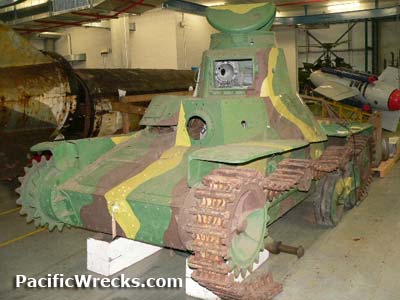|
|
|
|
| Missing In Action (MIA) | Prisoners Of War (POW) | Unexploded Ordnance (UXO) |
| Chronology | Locations | Aircraft | Ships | Submit Info | How You Can Help | Donate |
|
| IJN Kure 5th SNLF Tank Platoon  AWM August 1942  Anderson October 19, 1942  Phil Bradley 2006 |
Tank History Delivered to the Imperial Japanese Navy (IJN) as Type 95 Ha Go Light Tank serial number 1614. Wartime History Assigned to the Kure 5th Special Naval Landing Force (Kure 5th SNLF), Tank Platoon and transported as cargo to the South Pacific. On August 24, 1942 departs Rabaul as cargo aboard either Nankai Maru or Kinai Maru as part of Operation RE the Japanese landing at Milne Bay. On August 25, 1942 in the afternoon the convoy is spotted by a RAAF Hudson near Kitava Island then targeted by twelve P-40E Kittyhawks and a Hudson that bomb and strafe without serious damage. By 11:30pm the convoy enters Milne Bay and Daihatsu landing barges begin to land the SNLF at two locations. Due to dense fog the Japanese land further to the east than planned. On August 26, 1942 in the early morning hours this tank was loaded into a Daihatsu landing barge and landed at the "Western Landing Point" to the east of Waga Waga. Meanwhile, Type 95 Ha Go (Milne Bay No. 2) landed in another Daihatsu landing barge at the same location. Ashore, the tanks with SNLF follow the rough, muddy main road (Route 5) to engage the first resistance, an Australian Army patrol of 14 soldiers led by Lt. Bert Robinson and force them to fall back. By dawn, the tanks and SNLF were advanced toward Koebule Mission (KB Mission). On August 27, 1942 after dark, the tanks advanced to the eastern edge of Koebule Mission (KB Mission). The defending Australian Army 2/10 Battalion soldiers heard their engines and saw their headlights and initially mistook them for friendly Bren Gun carriers arriving as reinforcements. At 8:00pm the tanks supported by SNLF marines attacked B Company on the north side of the road. Shortly afterwards the second tank attacked C Company on the south side of the road nearest to Milne Bay. Machine gun fire with tracers from the tanks set fire to a hut and caused grass fires. The Australians lacked anti-tank weapons but attempted to use sticky bombs to disable the tanks but they failed to stick or detonate. On August 28, 1942 around midnight, the Japanese captured KB Mission then continued to advance westward and successfully crossed the Gama River. On August 29, 1942 both tanks became bogged down facing westward on the main road (Route 5) before reaching Rabi (Rabe) one in a ditch and the other along the roadway. Afterwards, the Japanese removed their main guns and machine guns then abandoned them. When the Australians discovered the tanks were abandoned, soldiers were sent forward to disable them. Lt. Aubrey Shindler from 25 Battalion was the first to reach the tanks and later reported neither was damaged and were not defended. He used explosives to damage the tracks and engines and later earned the Military Cross for his actions. On August 31, 1942 after the Japanese were defeated attacking No. 3 Strip, they withdrew eastward. By evening both tanks were inside Allied lines as the Australians advanced eastward toward Gama River. For the remainder of the battle, Australian soldiers passing on the main road would walk past the tanks or pose for photographs. Wreckage After the battle, both tanks were moved to the Allied base area at Gili Gili. Later, both main guns were found and reinstalled in each turret. Afterwards, both tanks were shipped to Australia arriving by the middle of October 1942 and underwent technical evaluation then toured on a war bond drive. Postwar At the end of World War II, both tanks were sold by Commonwealth disposals auction and purchased by Huges Trading Company in Coburg, Victoria and stored in their outdoor yard. Display In the middle 1970s, it purchased by John Belfield and displayed at the Melbourne Tank Museum, with a replacement replica main gun and right tread. In 2005, when the Melbourne Tank Museum closed, this tank was placed on auction and was acquire by the Australian War Memorial (AWM) and placed into storage at the Treloar Technology Centre (AWM Annex). Afterwards, meticulously restored by the museum and remains in storage at the AWM Annex. References Milne Bay 1942 (1992) pages 137 (The Tanks Arrive), 150 (Robinson shooting), 157 (Men Against Tanks), 170 (The Tanks Arrive, 171 (map), 180 (map August 28, 1942), 182 (The Tanks Advance), 186 (Tank Rumors), 200 (map August 29, 1942, photo), 203-204 (End of the Dreaded Tanks), 237 (map August 31, 1942), 241 (photo), 283 (photo), 306 (photo main guns), 399 (photo Japanese good luck flag yosegaki Hinomaru found inside tanks), 344 (photo) History of Battles of IJA Tanks / Milne by Akira Takizawa Thanks to Phil Bradley for additional information Contribute
Information Last Updated
|
Type 95 Photo Archive |
| Discussion Forum | Daily Updates | Reviews | Museums | Interviews & Oral Histories |
|